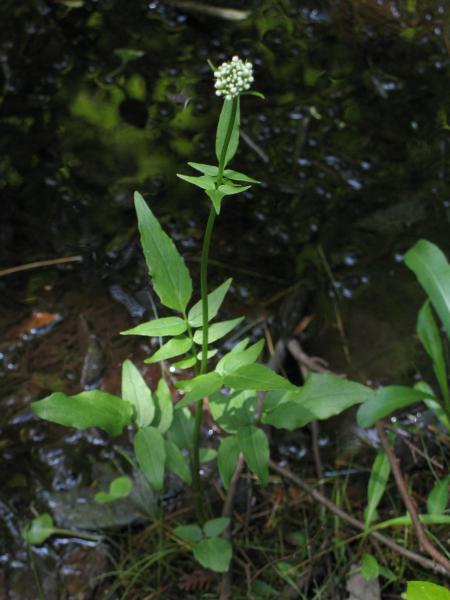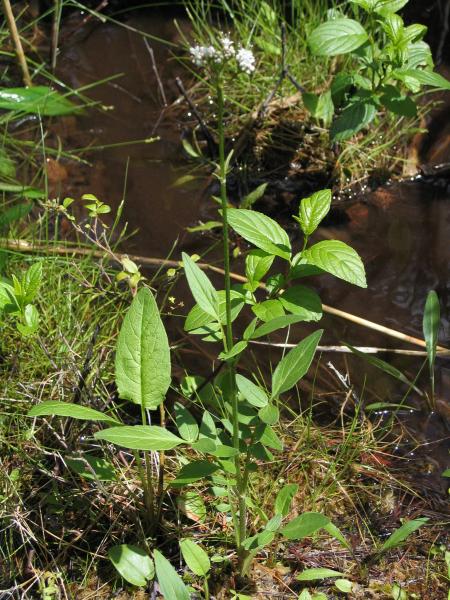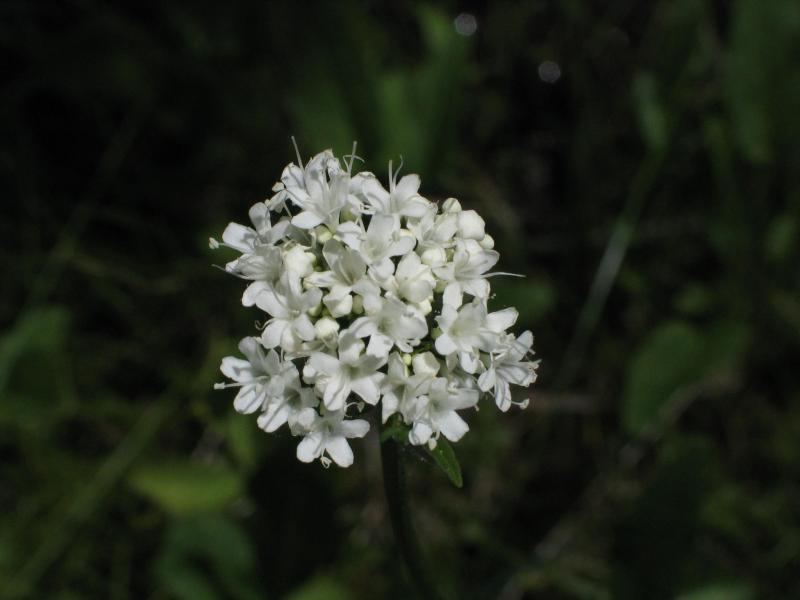Marsh Valerian
Valeriana uliginosa (Torr. & Gray) Rydb.
- Class
- Dicotyledoneae (Dicots)
- Family
- Caprifoliaceae (Honeysuckle Family)
- State Protection
- Endangered
Listed as Endangered by New York State: in imminent danger of extirpation in New York. For animals, taking, importation, transportation, or possession is prohibited, except under license or permit. For plants, removal or damage without the consent of the landowner is prohibited.
- Federal Protection
- Not Listed
- State Conservation Status Rank
- S1S2
Critically Imperiled or Imperiled in New York - Especially or very vulnerable to disappearing from New York due to rarity or other factors; typically 20 or fewer populations or locations in New York, very few individuals, very restricted range, few remaining acres (or miles of stream), and/or steep declines. More information is needed to assign either S1 or S2.
- Global Conservation Status Rank
- G4
Apparently Secure globally - Uncommon in the world but not rare; usually widespread, but may be rare in some parts of its range; possibly some cause for long-term concern due to declines or other factors.
Summary
Did you know?
All of our existing populations were known from historical records from the early 20th century and one as far back as 1870.
State Ranking Justification
There are four existing populations which are all in good to excellent condition. A fifth recent population was extirpated by Phragmites. There are 21 historical records which should be surveyed more extensively although some of them have been extirpated by changes in hydrology.
Short-term Trends
The four existing populations seem stable with a large number of plants in protected areas.
Long-term Trends
This plant was never documented to be very common in the state but there were over 20 historical records and many of them have become extirpated by changes in wetland hydrology and vegetation or by development.
Conservation and Management
Threats
Succession of open wetlands to a closed swamp canopy is a threat. A significant change in hydrology could also threaten the plants. One population has probably been extirpated by Phragmites.
Conservation Strategies and Management Practices
Prevent disruptions of the wetland hydrology by beaver or other human disturbances. Prevent displacement of populations by invasive species such as phragmites, purple loosestrife or the common valerian.
Research Needs
Research is needed to determine if the invasive common valerian can outcompete marsh valerian and may have displaced it in some of its historical wetlands, or whether it threatens its current locations.
Habitat
Habitat
Marsh Valerian has been found in a variety of wetland types in New York State (though usually not in marshes). Most of these sites share certain characteristics: alkaline or calcareous groundwater, an open aspect (or small openings within forests), and peaty, saturated soils (New York Natural Heritage Program 2007). Calcareous swamps and wet woods, chiefly with Larix and Thuja (Fernald 1970). Bogs, swamps, and meadows (Gleason 1952). Marshy meadows, swamps and bogs (Gleason & Cronquist 1991).
Associated Ecological Communities
- Marl fen
(guide)
A wetland that occurs on a bed of marl. Marl is a whitish substance that is deposited from water that has a lot of calcium dissolved in it. The whitish substance is calcium carbonate, people used to harvest marl to lime agricultural fields. The marl substrate is always saturated, may be flooded, and has a very high pH, generally greater than 7.5. The main source of water is always groundwater. The plants are often sparse and stunted. Marl fens may occur as small patches within a rich graminoid fen.
- Northern white cedar swamp
(guide)
A swamp that occurs on organic soils in cool, poorly drained depressions in central and northern New York, and along lakes and streams in the northern half of the state. These swamps are often spring-fed with continually saturated soils. Soils are often rich in calcium. The characteristic tree is northern white cedar, which makes up more than 30% of the canopy cover.
- Red maple-tamarack peat swamp
(guide)
A swamp that occurs on organic soils (peat or muck) in poorly drained depressions. These swamps are often spring fed or enriched by seepage of mineral-rich groundwater resulting in a stable water table and continually saturated soil. The dominant trees are red maple and tamarack. These species usually form an open canopy (50 to 70% cover) with numerous small openings dominated by shrubs or sedges.
- Rich graminoid fen
(guide)
A wetland of mostly grasses usually fed by water from highly calcareous springs or seepage. These waters have high concentrations of minerals and high pH values, generally from 6.0 to 7.8. Plant remains do not decompose rapidly and these grasses usually grow on older, undecomposed plant parts.
- Rich shrub fen
(guide)
A wetland with many shrubs that is usually fed by water from springs and seeps. These waters have high concentrations of minerals and high pH values, generally from 6.0 to 7.8. Plant remains in these fens do not decompose rapidly and thus the plants in these fens usually grow on older, undecomposed woody plant parts.
Associated Species
- Acer rubrum
- Betula pumila (bog birch)
- Bromus ciliatus (fringed brome)
- Calopogon tuberosus
- Carex lasiocarpa
- Carex leptalea (bristle-stalked sedge)
- Carex stricta (tussock sedge)
- Dasiphora fruticosa (shrubby-cinquefoil)
- Eleocharis rostellata (walking spike-rush)
- Juncus balticus
- Maianthemum stellatum (starry Solomon's-seal)
- Myrica pensylvanica
- Pycnanthemum virginianum (Virginia mountain-mint)
- Rhododendron groenlandicum (Labrador-tea)
- Ribes hirtellum (northern gooseberry)
- Schoenoplectus acutus
- Sphagnum
- Thelypteris palustris
- Toxicodendron vernix (poison-sumac)
Range
New York State Distribution
There are historical records for Marsh Valerian scattered throughout the state, from Dutchess County north.
Global Distribution
Marsh Valerian is found in eastern mainland Canada (Ontario, Quebec, and New Brunswick) and in scattered locations in the upper midwestern and northeastern United States. It occurs in the New England states (excluding Connecticut and Rhode Island), New York and New Jersey in the east, is considered extirpated in Ohio, and is found in Indiana, Illinois, Michigan, and Wisconsin.
Identification Comments
General Description
Marsh Valerian is a perennial wildflower reaching up to 1 m tall. It has a basal rosette of mostly simple, roughly egg-shaped, petiolate leaves. From this base arises an erect stem with 3-6 pairs of opposite, pinnate leaves 6-16 cm long. The flowers form a fairly dense, ball-shaped infloresence. Each individual flower is white to pinkish or purplish, with 5 petals, each 5-7 mm long, united at the base to form a tube.
Best Life Stage for Proper Identification
Marsh Valerian is most easily identified when in flower, though it may be possible to identify from fruiting or vegetative stems, or even from a basal rosette.
Similar Species
The only other species of Valeriana in New York is V. officialis, a European species which is commonly found in wet meadows in the summer. It is taller than our native Valerian and has stems which are pubescent at the nodes. Its basal leaves are not simple but pinnately divided into numerous segments.
Best Time to See
Marsh valerian flowers in mid-May to early July, the fruits persisting into September.
- Flowering
- Fruiting
The time of year you would expect to find Marsh Valerian flowering and fruiting in New York.
Marsh Valerian Images
Taxonomy
Marsh Valerian
Valeriana uliginosa (Torr. & Gray) Rydb.
- Kingdom Plantae
- Phylum Anthophyta
- Class Dicotyledoneae
(Dicots)
- Order Dipsacales
- Family Caprifoliaceae (Honeysuckle Family)
- Order Dipsacales
- Class Dicotyledoneae
(Dicots)
- Phylum Anthophyta
Additional Common Names
- Mountain Valerian
- Swamp Valerian
Synonyms
- Valeriana sitchensis ssp. uliginosa (Torr. & Gray) F. G. Mey.
Additional Resources
Best Identification Reference
Gleason, Henry A. and A. Cronquist. 1991. Manual of Vascular Plants of Northeastern United States and Adjacent Canada. The New York Botanical Garden, Bronx, New York. 910 pp.
Other References
Crow, Garrett E. 1982. New England's Rare, Threatened, and Endangered Plants. Prepared for the United States Department of Interior, Fish and Wildlife Service, Northeast Region. June 1982.
Crow, Garrett E. and C. Barre Hellquist. 2000. Aquatic and Wetland Plants of Northeastern North America: A revised and enlarged edition of Norman C. Fassett's a Manual of Aquatic Plants. Volume One: Pteridophytes, Gymnosperms, and Angiosperms: Dicotyledons. The University of Wisconsin Press. Madison, Wisconsin. 536 Pages.
Fernald, M.L. 1950. Gray's manual of botany. 8th edition. D. Van Nostrand, New York. 1632 pp.
Haines, Arthur and Thomas F. Vining. 1998. Flora of Maine. A Manual for Identification of Native and Naturalized Vascular Plants of Maine.
Holmgren, Noel. 1998. The Illustrated Companion to Gleason and Cronquist's Manual. Illustrations of the Vascular Plants of Northeastern United States and Adjacent Canada. The New York Botanical Garden, Bronx, New York.
Mitchell, Richard S. and Charles J. Sheviak. 1981. Rare Plants of New York State. Bull No. 445. New York State Museum. Univ. of New York. State Ed. Department Albany, NY.
New York Natural Heritage Program. 2010. Biotics database. New York Natural Heritage Program. New York State Department of Environmental Conservation. Albany, NY.
New York Natural Heritage Program. 2024. New York Natural Heritage Program Databases. Albany, NY.
Newcomb, Lawrence. 1977. Newcomb's Wildflower Guide: An Ingenious New Key System for Quick, Positive Field Identification of the Wildflowers, Flowering Shrubs, and Vines of Northeastern and North-Central North America. Little, Brown and Company. Boston.
Voss, Edward G. 1996. Michigan Flora Part III. Dicots Concluded (Pyrolaceae - Compositae). Cranbrook Institute of Science Bulletin 61 and University of Michigan Herbarium. 622 pp.
Weldy, T. and D. Werier. 2010. New York flora atlas. [S.M. Landry, K.N. Campbell, and L.D. Mabe (original application development), Florida Center for Community Design and Research http://www.fccdr.usf.edu/. University of South Florida http://www.usf.edu/]. New York Flora Association http://newyork.plantatlas.usf.edu/, Albany, New York
Weldy, Troy W. and David Werier. 2005. New York Flora Atlas. [S.M. Landry, K.N. Campbell, and L.D. Mabe (original application development), Florida Center for Community Design and Research. University of South Florida]. New York Flora Association, Albany, NY. Available on the web at (http://newyork.plantatlas.usf.edu/).
Links
About This Guide
Information for this guide was last updated on: December 30, 2008
Please cite this page as:
New York Natural Heritage Program. 2024.
Online Conservation Guide for
Valeriana uliginosa.
Available from: https://guides.nynhp.org/marsh-valerian/.
Accessed July 26, 2024.



